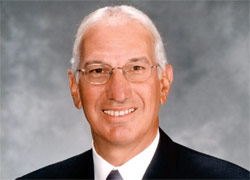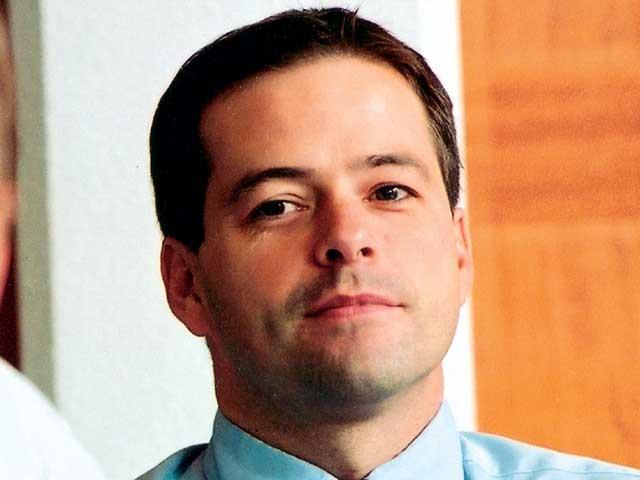 ITA president Dirk Von Holt |
Forklift markets in the USA, Europe, Japan and China showed growth in 2004 thanks to healthy local economies. That was despite the influence of the Iraq war and the fight against terrorism on the US economy, and the burden of higher steel and fuel prices. CHRISTINE LIEW reports.JapanAt the President's Forum during the Industrial Truck Association's (ITA) annual meeting in Miami, USA, in October, Japan Industrial Vehicles Association (JIVA) president Takeo Shibuya reflected on Japan's economic recovery.
"Last year, I said the Japanese economy was probably following a path of mild recovery and I cited 1.4 per cent as a growth figure based on an average of some private research institutes," he said.
However, that figure was too modest, Shibuya said. During fiscal year 2003, Japan's gross domestic product (GDP) showed growth of 3.2 per cent.
In 2004, Japan's forklift sales, based on shipments, grew by 10 per cent from January to September. Shibuya attributed the growth to Japan's "satisfactory" economy.
"By truck class, Class 1 increased by 13 per cent, Class 2 10 per cent, Class 3 11 per cent and Classes 4 and 5 eight per cent," he said.
USAIn the US, all three retail markets - Mexico, Canada and the US - were up 17 per cent as at September 2004.
That was despite the Iraq war, the fight against terrorism and the rising costs of fuel and scrap steel. Positive indicators for the US economy included an increase in consumer spending and a low unemployment rate.
ITA president Dirk Von Holt said members were confident the year would end on a strong note.
Three months before the year's end, the ITA's board of directors filled in a quarterly Retail Sales Guestimates Survey and estimated the next quarter's (October-December 2004) growth for all five forklift classes.
The markets for all classes showed growth, with electric narrow aisle trucks attracting the highest average estimated increase at 20 per cent.
The directors arrived at their estimates through discussions with their marketing divisions and dealers.
 Raymond Corporation president James Malvaso |
Raymond Corporation president and chief executive James Malvaso said his company turned in a "strong" performance for 2004, with business up 35 per cent.
"The most significant influence was the North American forklift market itself, which was up by about 20 per cent from 2003," Malvaso said.
He said Raymond Corp's new products contributed to the company's robust growth.
"We launched two new 'from the ground up' trucks that are really popular with buyers. The Model 102XM pallet truck is highly manoeuvrable in tight spaces while the Model 7400 Reach-Fork Truck has an open view mast design that provides improved floor level, eye level and high level visibility," he said.
"Raymond also introduced a full range of fleet services options, from a CD-ROM based package that can be installed on a customer's PC, to complete fleet management, which we are selling to our large customers."
ChinaChina Industrial Truck Association secretary general Su En Yi told the ITA meeting the Chinese forklift market had been growing rapidly.
"This year (2004) sales of industrial trucks have grown 38 per cent per month compared with the same period last year. The forecast for sales through to the end of this year is 60,000 units," Su said.
He said the Chinese forklift market was still "rather young", but its growth had been accelerated by input from foreign companies.
"Many foreign companies (have) moved into China and brought with them modern technology (which has) helped accelerate the Chinese industrial truck industry. The foreign companies also brought with them logistics technology that (has) also helped," he said.
Rapid growth for the industry has meant the association had a role to play in assisting members find suppliers for forklift parts.
"Our members often need our help to find appropriate suppliers for masts and seals. We provide this service to them," Su said.
The association also introduced ZF, Kaup and Cascade products to Chinese companies with the aim of improving product quality.
The rise and rise of steel pricesVon Holt said the cost of scrap steel had risen from USD110 a ton to more than USD300 in recent months.
"We calculated this price increase will have a negative impact of about USD35 million for our industry. Many companies have already decided to pass the extra cost to the end user," he said.
"But our concern is not only scrap steel, but also lead and coke. A recent survey shows 62 per cent of our members feel that is a significant impact to our industry's profitability."
Shibuya echoed Von Holt's concerns.
"The price of scrap iron is settling down after peaking in March, but the price is more than three times as much as it was three years ago," he said.
"On a micro level, it has put pressure on the earnings of companies that have acted as engines in the economy's recovery."
Shibuya said that could give rise to "psychological anxiety" that might suppress an increase in share prices and, subsequently, suppress investment in plant and equipment.
Although China had played a part in Japan's economic recovery, Shibuya said the rise in steel prices was related to China's continued growth.
"The backdrop to these rises in prices has been the large-scale increase in consumption of steel and iron amid the sudden rise in demand due to the recovery of the world economy, particularly the continued growth in China," he said.
Japan's total exports in 2003 increased 4.7 per cent over 2002 and, of that, exports to China showed an enormous increase of 33.3 per cent.
Shibuya said the economies of Brazil, Russia and India were also fast-growing.
"These are promising markets for our industry in the future but it is not good for these economies to overheat. We would like to see the economies of these countries managed in a balanced fashion," he said.
The year aheadThe bodies representing the forklift industry in the USA, Japan and Europe have high hopes for 2005.
JIVA has not made a forecast for the forklift market for next year, but expects demand in Japan to continue rising.
The ITA predicted 36 per cent growth over the next six years to 225,000 forklifts, but said the increase would not be spread evenly each year.
"Six per cent annually is of course wishful thinking ... but the next peak will be higher than the last," Von Holt said.
Future technological revolutions would impact the industry positively.
"The recent business trend survey done by our supplier group resulted in 40 per cent of our members believing fuel cell-powered lift trucks are only two to five years away," Von Holt said.
Other advances that could impact the industry include hydraulic-free operations for steering and lifting, and further development of nanotechnology.
Malvaso said Raymond anticipated continued growth in 2005 but "probably not as strong as in 2004".
"The North American forklift market growth is projected to be modest at 5 per cent to 8 per cent (in 2005)," he said.
The company would continue to research applications for its ACR System on other models.
"The widespread acceptance of our ACR System since its introduction in 2001 made us the first in North American to successfully introduce AC powered trucks for narrow aisle applications," Malvaso said.
"We are also working with developers of radio frequency identification and fuel cell technologies for warehouse applications in the event these technologies prove beneficial," he said.
EuropeFederation Europeenne de la Manutention (FEM) president Ambrogio Bollini said the European forklift market would increase 8 per cent in 2005.
However, he said it was important to realise that the present market size was still below the peak reached in 2000.
"It is a common opinion that the market will be back to the year 2000 level no earlier than 2006," Bollini said.
Swedish forklift and container handler manufacturer Kalmar Industries expects its full-year sales for 2004 to increase from its 2003 result.
 Kalmar spokesman Benoit Passard |
Spokesman Benoit Passard said latest figures indicated container traffic was growing faster than world trade. Kalmar estimated container-handling equipment demand to grow at half the rate of container throughput growth, creating the potential for large orders from port operators, the company's biggest customer segment.
"The most significant business drivers are container throughput growth, the development of industries such as paper and steel production, and the trend in consumer consumption in the USA," he said.
"Growth in Europe has been strong but the real increase is in Asia."
Kalmar had striven to capitalise on Asia's growth potential by establishing an assembly plant in Shanghai, China, last year - a move that would "significantly increase assembly capacity" in the area.
Passard said the service business was a key factor in Kalmar's growth strategy.
"The service business represents (our) single largest growth area. Europe in particular is seen to provide opportunities as customers re-evaluate their own service activities," he said.
"The service and spare parts business accounted for 24 per cent of Kalmar's net sales in 2003."
Commenting on the year ahead, Passard said Kalmar would "continue to set the standards in the industry by constantly bringing new, innovative products and services to the market".